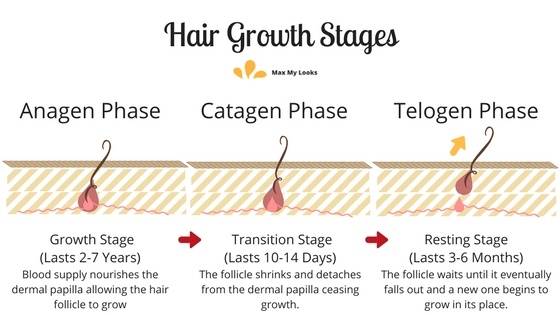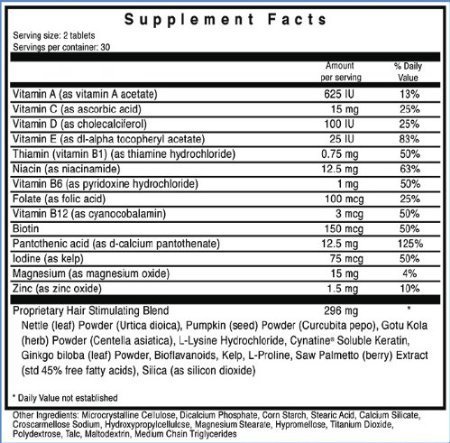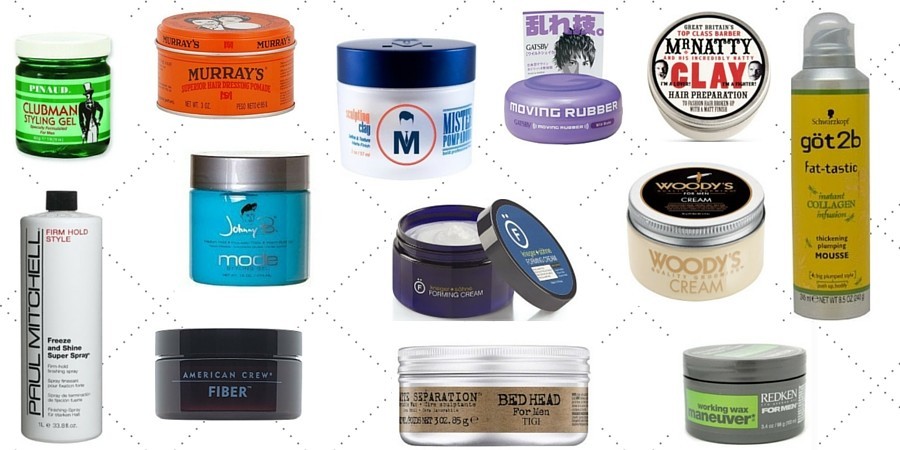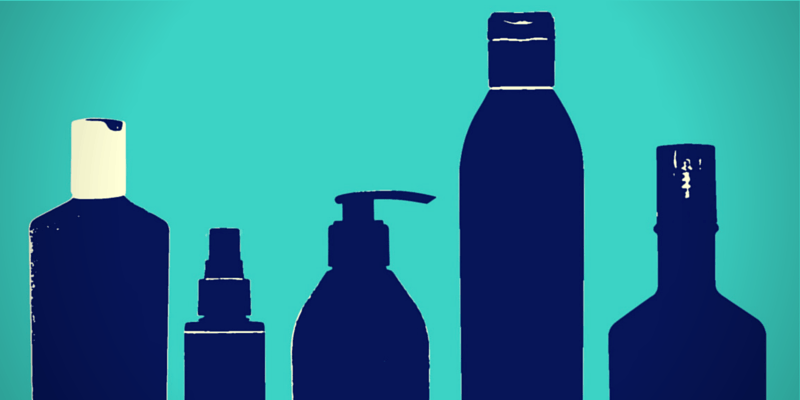If you want to know how to make your hair grow back as fast as possible you’re at the right place.
Regardless of your gender, we’ve all gone through times when we wanted our hair to grow sooner rather than later.
Maybe you have a friend whose hair grows really fast and want the same results.
Maybe you’re dealing with genetic hair loss or have patchy spots.
Maybe you just got a bad haircut and want the misery to end (we can definitely relate to that one). No matter the reason, these tricks and home remedies will super-charge the growth of your hair follicles to their maximum potential. If you’re knocking off every method in the list below or even the majority of them you’ll be doing all you can aside from getting extensions or a wig for a thicker head of hair.
First, we’ll walk you through some of the factors that affect hair growth and answer the question of how fast the average person’s hair grows. Then, we’ll talk about the life-cycle each hair follicle goes through and the phase you want your hair to be in for as long as possible to get thicker hair. Finally, we’ll go through each method in-depth and at the end we’ll recommend our #1 rated hair growth supplement for strong and healthy hair.
So, without further ado, let’s begin.
How Fast Does Hair Grow Naturally?
For the average person, their hair grows anywhere between a quarter of an inch to half an inch per month.
This means a rate of about six inches per year.
Keep in mind that this is if you’re doing everything right and your hair is at its healthiest.
Any faster than that is extremely rare and would be considered an outlier (and the subject of our envy).
Not bad, but if you want to grow your hair out longer and find yourself on the slower end of average you might be wondering why it’s taking so long.
Factors Affecting The Rate of Hair Growth
There are a number of factors that influence how fast your hair grows. Keep in mind that we’re talking about the hair on your scalp and not the rest of your body.
- Age
- Genetics
- Health conditions and certain medications
- Stress
- Nutritional deficiencies
- Physical damage to the hair follicles
- Hormones (ex. Pregnancy for women. DHT for men)
Some of these you have control over and some of them you don’t. Focus on what you can control (stress, diet, physical damage, and to a certain extent your hormonal balance and the medications you take) and forget the rest.
We’ll be covering some of the factors you do have control over in detail further below.
The Stages of Hair Growth
You have roughly 100,000 follicles of hair on your scalp.
You shed anywhere from 50-150 of these hair follicles daily.
Yet because your hair is constantly shedding and growing, you likely never even notice your hair falling out unless you’re losing excessive amounts related to balding or for other health reasons (such as chemotherapy).
This is because each follicle goes through its own individual lifecycle separate from the other follicles. There are three main stages in total:
The Anagen Phase
- The ‘growing’ phase of the lifecycle.
- Typically lasts for 2-5 years but as many as 8 in some cases.
- About 90-95% of all the follicles on your head are currently in this phase.
The Catagen Phase
- The ‘transitional’ phase.
- Only lasts for about 10 days.
- The follicle shrinks and is cut off from the blood supply and the cells that grow your hair.
The Telogen Phase
- The ‘resting’ phase.
- Lasts for 3-6 months
- The remaining 5-10% of your hair follicles are in this phase.
- At the end of this phase, the hair follicle will fall out and a newer one will grow.
As you might have guessed, you want your follicles to be in the anagen phase for as long as possible. This is the only time when they’re actually growing! We’ll discuss in the next section how you might go about inducing the follicles to begin or remain in this stage.
Home Remedies For Longer and Thicker Hair
The following methods have been proven to help grow healthy hair faster. Do as many of them as you can for the best results.
As you will soon learn, a large part of growing your hair out quicker is simply avoiding damage to the follicles themselves so they have the opportunity to get longer. Don’t expect miracles overnight.
Eat a Hair Healthy Diet
Just as every great skincare routine begins from the inside out, the same applies for hair. Fixing your diet sets the foundation and should be considered a prerequisite because every other method on this list will work less effectively without the nutrients that form the structure and support the cells that build hair.
Certain nutritional deficiencies can impede growth or even cause your hair to fall out.
Here’s what matters the most:
Protein
Your hair is made up of mostly protein — 90% in fact of one particular kind called keratin. While you won’t find keratin specifically in foods, eating a high protein diet will give your body the amino acids it needs to help build keratin and thus the actual hair follicle itself.
Biotin
Biotin, sometimes known as Vitamin H, is a B-complex vitamin that has hair loss as one of its first symptoms of deficiency. While it’s unlikely you’re deficient (you only need 30 micro-grams per day), some research suggests that eating more biotin rich foods might help strengthen brittle hair so make sure you get enough.
Eggs, grains, legumes and nuts such as almonds are all great sources of biotin.
Vitamins B, C, D, and E
These are the antioxidant free radical fighting vitamins that are a standard of every healthy diet. Oxidative stress can cause the hair follicles to fall out prematurely so eat or supplement these vitamins to help prevent that from happening.
- Vitamin B5 (pantothenic acid) helped thicken the hair follicles and made them more resilient to breakage in one study.
- Vitamin C helps the dermal papilla cells on the scalp, which are the cells responsible for connecting your hair follicles to the blood supply and provide it nutrients, to develop more quickly.
- Vitamin D deficiency has been linked to alopecia areata which is when your body’s immune system mistakenly attacks hair causing patches of hair loss.
- Vitamin E increased the hair count in men when applied topically to the scalp by 34.5% thanks to its anti-inflammatory properties which reduced the effects of oxidative stress on the hair follicles.
Broccoli, spinach, and other leafy green vegetables are all great sources of these vitamins. Sunlight of course is the best source of Vitamin D but if you don’t get enough we recommend supplementation because it’s unlikely you’re getting enough from the food you eat.
Also a sidenote about Vitamin A: While it’s true it also acts as an antioxidant like the rest of these vitamins, ingesting too much has actually been linked to hair loss so we caution to avoid Vitamin A toxicity for the health of your hair (among other reasons).
Zinc
Can help instances of telogen effluvium which is when an abnormal number of hair follicles suddenly enter the telogen phase. As we described in the previous section, this means that the follicles are not growing but resting and preparing to fall out! Zinc deficiency is also associated with three other types of hair loss in addition to T.E. according to this study.
Foods high in zinc include oysters, grass-fed beef, pumpkin seeds, and lamb.
Iron
Found in the hemoglobin of your red blood cells, iron is responsible for transporting oxygen in your blood from your lungs to the rest of your body. As you will soon learn, this is critical because decreased circulation to the scalp is at least partly responsible for male hair loss and a total deficiency in iron can even cause hair to fall out in women.
You can find iron in beef, spinach, and seafood like sardines or clams.
Omega 3 Fatty Acids
Omega 3s can be found in fish oil and are essential for hair health because not only do they reduce inflammation cutting the chances of follicles falling out prematurely but they are also responsible for lubricating the cuticle and preventing dry hair which is more prone to breakage.
One study performed on women with thinning hair found that 6 months of Omega 3 and Omega 6 supplementation helped increase hair density and reduced the percentage of follicles in the telogen phase.
Gelatin
Gelatin is really a form of hydrolyzed collagen composed of the bones and tissues of cows and sometimes other animals. It is essential for healthy hair growth because the papilla cells which link the follicles to your blood supply are made of collagen. Since gelatin contains the proteins and peptides of the bones they also help build the structure of the actual follicle which is mostly made of protein.
Our recommended source of gelatin is good old-fashioned bone broth.
Exfoliate Your Scalp Once or Twice A Week
Think of your hair as a garden. Your scalp is the soil in which the beautiful plants called your hair grow out from. But, as any good gardener will tell you, you will need to perform maintenance and rid the soil of the weeds and pests like dandruff, gunk, dead skin cells, excess sebum build-up, and so on that impede the growth of your precious locks.
Excuse the metaphor but exfoliating your scalp really can go a long way in ensuring you grow healthier hair. Certain types of scalp infections like ringworm can cause hair to fall out and the buildup of leftover styling products that weigh the hair down can be removed by rinsing the scalp with something as ordinary as apple cider vinegar.
Not to mention it will help maintain a proper pH balance and a healthy microbiome combating fungal infections and bacteria. Just don’t overdo it because too much exoliating will strip your hair of its natural oils and cause physical damage to the cuticle.
Give Yourself A Scalp Massage
A scalp massage doesn’t just feel great: it helps stimulate blood flow to your head delivering the nutrients and oxygen needed to help grow hair. It also reduces stress which in excessive amounts can also
Every night before bed, gently rub your fingers in a circular motion massaging the scalp for about 3-5 minutes.
If you have your doubts, one Japanese study performed on men found that a daily scalp massage of 4 minutes increased hair thickness by a significant amount after a period of 6 months.
Sure 6 months is a long time but the results didn’t all come at once: the hair gradually thickened over time as you can see in the above graph.
A separate study found similar success with its authors noting:
Essential Oil Infusion
One way to increase the efficacy of a scalp massage is to add an essential oil or two into the routine which can boost hair growth even more.
You can apply the oils directly onto your scalp and then depending on how long your hair is, use a comb to distribute it down the length of your hair to its ends.
Our favorite essential oils for hair include the following:
- Coconut
- Castor
- Peppermint
- Rosemary
- Pumpkin Seed
Coconut oil acts as a natural conditioner moisturizing dry hair and is capable of penetrating the hair shaft deep thanks to its low molecular weight. Combine it with a massage to stimulate the follicles from the inside out. It’s also high in Vitamin E which reduces inflammation and was even found to be able to reduce protein loss of both damaged and undamaged hair.
Castor oil is also chock full of Vitamin E and fatty acids that bind and help protect the cuticle from damage.
Menthol which is found in peppermint oil acts as a vasodilator which means it will improve circulation to the scalp.
Rosemary and pumpkin seed oil we’ve covered in a separate guide about DHT blockers for hair loss. These work especially well for men because they inhibit the conversion of testosterone to DHT which contributes to male pattern baldness.
Whichever combination you end up using, we recommend warming the oils up a bit to further promote blood flow to your head and even leaving them on for longer sometimes by gently wrapping your head in a towel or showercap as they dry for a nice hair mask hot oil treatment.
Try The “Inversion Method”
If you’ve been frequenting YouTube for hair growth tips you may have seen vloggers rave about this trick with some of them claiming as much as an inch of hair growth in as little as a week.
If you’ve never heard of it before, the inversion method is a simple technique to promote hair growth. It’s a combination of a scalp massage and a hot oil treatment with the added effect of gravity.
For seven days in a row, you give yourself a scalp massage with your fingertips for about 5 minutes working across its entire area. At the same time you want your head inverted meaning you flip your hair upside down in order to force blood flow to the scalp. This in turn will provide your hair cells the nutrients and oxygen it needs to grow.
We highly recommend combining the scalp massage with hair promoting essential oils to increase its effectiveness.
Here’s a quick rundown that summarizes all the steps:
- Choose and have your oil of choice ready.
- Warm it up in a glass container but make sure it’s not boiling or overheated.
- Apply the oil so it makes direct contact onto the scalp focusing on your problem areas.
- Comb the oil through the rest of your hair.
- Flip your hair over the sink or while sitting in a chair at a comfortable angle.
- Massage in a clockwise and counter-clockwise direction with your fingertips.
After the 5 minutes are up simply cleanse your hair and rinse with water.
Adjust Your Shower Routine
Avoid taking steaming hot showers and use cold water instead. Warm water weakens hair and strips it of its natural oils which protects the hair from breakage. You don’t have to take super cold showers, you can use lukewarm and then end with a quick burst of cold water to seal the cuticle and close the pores of your scalp preventing gunk from getting in and hair from falling out.
That said, are you using shampoo every day? This is bad because shampoos also strip your hair of its oils especially ones that use harsh chemicals like sulfates. Consider shampooing less often — every other day or so is a good start. It’s also worth looking into replacing your current shampoo product with one designed specifically to promote hair growth. These can be different for men and women so try one specifically made for you.
What you do need to be using every day is a conditioner which will seal and replace the proteins and lipids inside the cuticle. A deep conditioner will repair damaged hair allowing your hair to grow longer without tears and split-ends.
To summarize:
- Use colder water.
- Skip the shampoo or use one that promotes hair growth.
- Condition EVERY DAY to hydrate and protect hair from damage.
Avoid Heat Damage and Chemical Treatments
Other than avoiding hot showers you also need to beware of any heat-styling techniques you’re performing on your hair with hot irons and hairdryers.
Always use a generous amount of thermal protector and go for the medium setting on your hairdryer avoiding anything over 450 degrees Fahrenheit.
If you absolutely must, first gently pat your head with a towel and let it air dry for a bit before using a heat protection spray and then dry your hair.
Coloring, highlights, and bleach also also damage the hair cuticle. The fewer treatments you get done, the less split ends and breakage your hair will experience and the longer it will be able to grow.
Avoid Breakage
Like we said before, a big part of growing your hair faster is simply getting out of its way and avoiding harm to the follicles.
The following are tips that won’t make a big impact on their own but their benefits will add up the more of them you do:
- Replace cotton pillowcases with satin or silk.
- Don’t wrap your hair in a “traditional” towel but use a soft T-shirt or microfiber instead.
- Skip the ponytail and avoid using any tight hair bands that pull your hair.
- Use a wide tooth comb or boar bristle brush and never brush your hair when it’s soaked because that’s when it’s most fragile.
- When you do brush, begin from the bottom moving up toward the scalp to distribute the oils along the length of your hair and get the tangled ends out easier.
These will all help reduce frictional damage that causes the ends of hair to split and rip apart.
If you Have Breakage Trim Your Hair!
If your hair has already grown a decent length, sure frequent trims at the salon won’t make it any longer but what it will accomplish is avoid breakage by cutting off the damaged ends of your hair. Taking just an eight of an inch off every 2-3 months can make a drastic difference to the appearance and health of your hair letting it grow longer over time.
It’s the mentality of quality > quantity.
Check out this guide for more tips on dealing with hair breakage and repairing broken hair.
Our Recommended Healthy Hair Growth Supplements
As you might guess, there’s no one size fits all solution here. The ideal hair supplement for you depends on your specific needs, your specific deficiencies. That’s why it’s best to look for a supplement that contains a variety of ingredients and nutrients rather than a specific kind to make sure you cover all your bases. Unless you already know what you’re deficient in, be on the safe side.
That said we have two recommendations here. One that works for both men and women as a general all-purpose hair supplement, and another specifically for men with male pattern baldness.
The first is called HairAnew by Naturenetics. As you can see from the ingredient list above, it contains Vitamin C, E, B5 (pantothenic acid) as well as zinc and biotin. That covers half (5/10) of the key vitamins and minerals we talked about earlier in this post. It also contains silica which is responsible for making hair stronger and shinier. If you’ve ever used a silicone-based shampoo you know what a difference it can make on the way your hair looks and feels.
This supplement also contains ingredients that benefit your skin and nails so if you’re looking for something to address those needs in addition it’s not a bad one to consider.
Our favorite supplement for men experiencing male pattern baldness is called Ultrax Labs Hair Rush. The reason we’re recommending a different supplement for this condition is because MPB has a specific cause that needs certain ingredients in order for it to have a chance of working.
Again, not only does it contain Vitamins C, D, E, B5 (pantothenic acid), biotin, and zinc covering 6 out of the 10 most important vitamins and minerals for healthy hair, it also contains three ingredient that inhibit the effects of DHT, the hormone primarily responsible for inducing hair loss in men. Those ingredients are:
- Nettle Powder (derived from the stinging nettle root)
- Pumpkin Seed Powder
- Saw Palmetto
It also contains keratin (the protein responsible for 90% of the hair follicle structure), gotu kola (improves circulation to the scalp), silica which we mentioned before, and L-Lysine which is an amino acid that amplifies the effect of DHT blockers helping them work more effectively, in addition to other useful ingredients.
If you want more information on why these ingredients are so important, we recommend reading this post to get a background on DHT and its role in hair loss.
Conclusion
They say patience is a virtue. When it comes to growing out your hair, we agree with whoever “they” are.
If you combine all of these methods and do other simple things like practicing stress relief and exercising daily to further improve circulation of blood to your scalp you will be doing everything you possibly can to help grow your hair out.
The rest of the game is just avoiding damage to the cuticle as your hair grows longer and longer.
If you found this guide helpful and would like to keep up with the latest from us, follow us on Twitter or Pinterest (@maxmylooks) for more.








